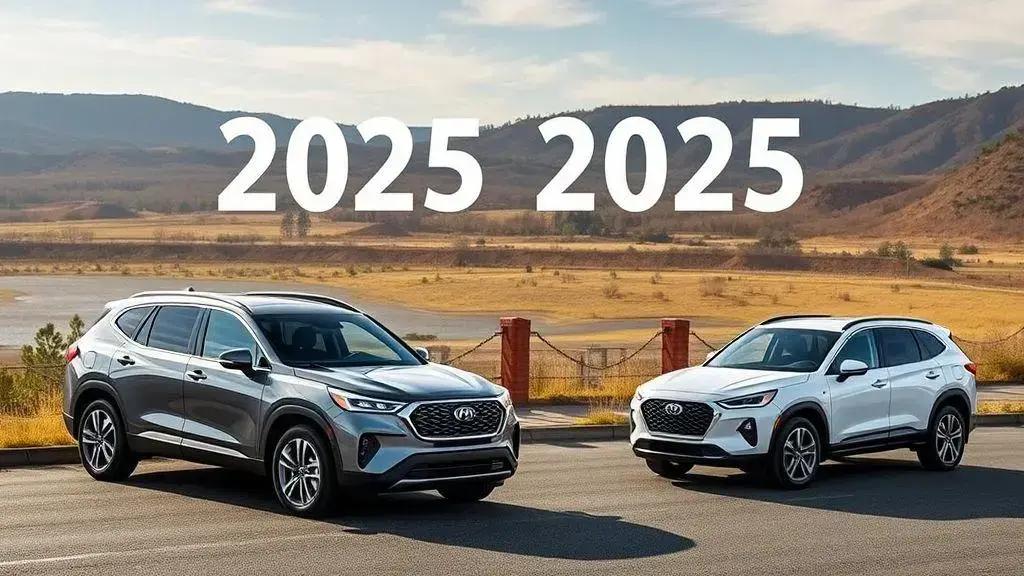Detailed car reviews highlight the best 2025 SUVs

Choosing the right SUV involves assessing safety ratings, understanding your primary use, and considering advanced features while prioritizing reputable sources for evaluations.
Detailed car reviews highlight the best 2025 SUVs that offer superior safety and performance. With so many choices available, it can be daunting picking the right one. But don’t worry! This guide will help you navigate through the features that matter most.
Top safety features of 2025 SUVs
When considering an SUV, safety should always be a top priority. The 2025 SUVs are equipped with numerous features designed to protect drivers and passengers alike. It’s crucial to understand what these features are and how they work to keep you safe on the road.
Key Safety Features:
Modern SUVs come with a variety of advanced safety technologies. Here are some of the standout features in the 2025 models:
- Automatic Emergency Braking: This system detects potential collisions and applies the brakes if you fail to react in time.
- Blind Spot Monitoring: This feature warns you of vehicles in your blind spot, making lane changes safer.
- Adaptive Cruise Control: This technology adjusts your speed to maintain a safe distance from the car ahead.
- Lane Departure Warning: Alerts you if you begin to drift out of your lane without signaling.
Each of these features plays a crucial role in enhancing the overall safety of 2025 SUVs. As you explore different models, consider how these systems work together to provide peace of mind while driving.
Why Safety Ratings Matter:
Checking safety ratings from organizations like the National Highway Traffic Safety Administration (NHTSA) and the Insurance Institute for Highway Safety (IIHS) can provide valuable insights. These ratings assess how well vehicles perform in crash tests and their safety features’ effectiveness. A high safety rating is often a good indicator of a reliable and secure vehicle.
Conclusion, the best SUVs for 2025 are not only about style and performance; they are designed with your safety in mind. Prioritizing vehicles with top safety features ensures a safer driving experience.
Comparing performance metrics
When evaluating 2025 SUVs, comparing performance metrics is essential. It allows buyers to understand how different models stack up in terms of power, handling, and efficiency.
Key Performance Metrics:
There are several important metrics to consider when comparing performance:
- Horsepower: This measure indicates the engine’s power output. More horsepower typically means quicker acceleration.
- Torque: Torque affects how quickly an SUV can respond to acceleration. Higher torque values can improve the overall driving experience, especially when towing.
- Fuel Efficiency: Measured in miles per gallon (MPG), this metric is vital for long-term cost savings. Look for SUVs that balance power with good fuel economy.
- Acceleration Times: How quickly an SUV can go from 0 to 60 mph showcases its responsiveness and power delivery, indicating overall performance.
The balance of these metrics is what makes an SUV truly enjoyable to drive. An SUV with high horsepower but poor fuel efficiency might provide thrilling performance but could cost more at the pump.
Driving Experience:
Another aspect to consider is the driving experience. Factors like ride comfort and handling impact how the vehicle performs in real-world scenarios. For instance, a vehicle with a stiffer suspension may provide sportier handling, while a softer suspension enhances ride comfort. Many 2025 SUVs come equipped with advanced suspension systems that adjust automatically based on driving conditions.
When comparing these performance metrics, it’s also vital to consider customer reviews and expert opinions. These insights can reveal how well a model performs daily, beyond the numbers. Understanding how each SUV feels on the road is key to finding the best fit for your driving preferences.
Best family-friendly SUVs for 2025

Finding the right SUV for your family in 2025 involves considering both safety and comfort. The best family-friendly SUVs provide a mix of spacious interiors, advanced safety features, and entertainment options to keep everyone happy on the road.
Top Family-Friendly Features:
As you’re researching options, look for these must-have features:
- Spacious Seating: SUVs like the Honda Pilot and Toyota Highlander offer ample room for up to eight passengers, making them perfect for family trips.
- Safety Ratings: High safety ratings from organizations such as NHTSA and IIHS matter. Models like the Subaru Ascent consistently receive top marks.
- Entertainment Systems: With available rear-seat entertainment options like screens and connectivity features, children can stay entertained on long drives.
- Storage Solutions: Adequate cargo space for strollers, sports gear, and groceries is essential in family-friendly SUVs. The Ford Explorer provides plenty of room for all your gear.
Families also want to ensure that their chosen SUV is equipped with technology like rearview cameras and parking sensors for added peace of mind when maneuvering in tight spaces.
Comfort and Convenience:
Comfort doesn’t stop at passenger capacity. SUVs such as the Kia Telluride feature spacious interiors with high-quality materials that make every ride enjoyable. Multiple climate controls provide comfort for everyone in the vehicle, ensuring that nobody feels too hot or too cold.
Moreover, easy access to the second and third rows is crucial, especially for younger kids. Look for features like one-touch sliding seats and wide door openings to make moving between rows a breeze. Safety latches and child seat anchors are essential for securing car seats easily and safely.
As you delve into options, keeping the family’s needs front and center will help you choose the best family-friendly SUV for your adventures.
How to choose the right SUV for your needs
Choosing the right SUV can feel overwhelming, but understanding your needs makes the decision easier. Whether you prioritize space, safety features, or performance, it’s critical to assess what matters most to you.
Identify Your Primary Use:
First, think about how you will use the SUV. Will it be primarily for family trips, commuting, or off-road adventures? Understanding your primary use helps you narrow down choices significantly.
- Family Transportation: If you have a large family, opt for a model with abundant seating and cargo space.
- Daily Commute: For city driving, consider a compact SUV that is easy to park and has good fuel efficiency.
- Off-Road Performance: If exploring rugged terrains is your goal, look for SUVs designed with off-road capabilities.
Once you clarify your needs, you can focus on specific features and metrics that align with them.
Safety Features:
Next, prioritize safety features that are crucial for your peace of mind. Modern SUVs come with a range of advanced safety technologies. Look for models that include:
- Electronic Stability Control: Helps maintain control during slippery conditions.
- Adaptive Cruise Control: Automatically adjusts speed to maintain a safe distance from the car in front.
- Automatic Emergency Braking: Detects obstacles and applies brake pressure if necessary.
These features can significantly enhance your driving experience and provide assurance on the road.
Test Drives and Reviews:
Don’t forget to take potential SUVs for a test drive. Getting a feel for the vehicle’s handling and comfort can make a big difference. Pay attention to how easy it is to get in and out, and how each SUV performs at different speeds.
Additionally, read customer reviews and expert ratings. Observing what others experience can help highlight both strengths and weaknesses of specific models. 2025 SUVs come with many options, so leveraging reviews to guide your choice is always wise.
Expert tips for evaluating SUV safety ratings
When it comes to buying an SUV, safety ratings are a key factor. Understanding how to evaluate these ratings can help you choose a vehicle that provides peace of mind on the roads. Before making a purchase, it’s vital to know where to look and what to compare.
Where to Find Safety Ratings:
Various organizations provide safety ratings based on crash tests and safety technology evaluations. The most reputable sources include:
- National Highway Traffic Safety Administration (NHTSA): NHTSA conducts rigorous crash tests and assigns ratings from 1 to 5 stars.
- Insurance Institute for Highway Safety (IIHS): IIHS evaluates vehicles for crashworthiness and provides ratings such as “Top Safety Pick” and “Top Safety Pick+.”
- Consumer Reports: This organization provides detailed safety assessments based on owner feedback and engineering evaluations.
Checking these ratings during your research phase will give you a clearer picture of how well a vehicle performs in safety tests.
Understanding the Ratings:
Once you locate the safety ratings, it’s important to understand what they mean. For example, a 5-star rating from NHTSA indicates superior safety performance. In contrast, IIHS ratings of “Good” or “Acceptable” signify a high level of crash protection.
Additionally, be aware of individual categories such as front impact, side impact, and rollover tests. These sections can highlight specific weaknesses or strengths in a vehicle’s design. 2025 SUVs often come equipped with various safety features, but the ratings provide a concrete understanding of how they function in real-world scenarios.
Additional Factors to Consider:
When evaluating safety, consider features like advanced driver-assistance systems (ADAS) that go beyond standard safety ratings. Features such as lane-keeping assistance, adaptive cruise control, and automatic emergency braking can greatly improve safety.
Researching customer feedback regarding safety in everyday use can also provide valuable insights. Potential buyers often share experiences related to how specific safety features worked in real life, giving you a better idea of what to expect.
Choosing the right SUV for your needs is crucial for safety, comfort, and performance. By evaluating safety ratings, understanding features, and considering your family’s specific requirements, you can find the perfect match. Prioritize reputable sources for safety ratings, and always take potential vehicles for a test drive. With the right research, you can feel confident in your decision and ensure a safe driving experience for you and your loved ones.
FAQ – Frequently Asked Questions about Choosing the Right SUV
What should I consider first when choosing an SUV?
Start by identifying your primary use, such as family transportation, commuting, or off-road adventures.
What are the best sources for SUV safety ratings?
Reputable sources include the National Highway Traffic Safety Administration (NHTSA) and the Insurance Institute for Highway Safety (IIHS).
How can test driving help in selecting the right SUV?
Test driving allows you to experience the SUV’s handling, comfort, and features firsthand, which is crucial for your decision.
What advanced safety features should I look for in an SUV?
Look for features like adaptive cruise control, automatic emergency braking, and lane-keeping assistance to enhance safety.





